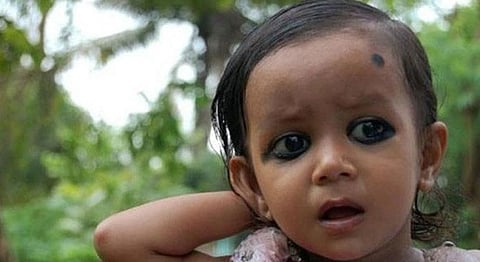
- HOMEGROWN WORLD
- #HGCREATORS
- #HGEXPLORE
- #HGVOICES
- #HGSHOP
- CAREERS
- ABOUT US
- CONTACT US

The birth of a girl child in families across India invoke a varied set of reactions, based on social perspective, economic background and cultural traditions. And for one particular village in Bihar, it means more greenery.
Dharhara village, which stands out against the backdrop of under-developed eastern Bihar’s abject poverty, is home to ‘mango girls’ and a unique tradition that aims to fight female infanticide, foeticide and dowry deaths with the power of trees. “The birth of a girl child is celebrated in my village,” explains Sulakshana Kumari who resides in Dharhara, where a girl’s birth is accompanied by the joyful singing of songs and the planting of mango trees for insurance.
As a security blanket for her future, every time a girl is born there, her parents plant as many mango trees as possible, making it one of the greenest pockets of its district. Education costs, dowry, marriage expenses and more are covered by the compensation these mangoes yield, and each girl inherits her trees eventually as well. “These trees are our fixed deposits,” describes Subhas Singh, a small-scale farmer in the village, whose daughter’s wedding expenses are taken care of by the 10 mango trees he planted the day she was born.
Female foeticide: An affluent problem?
Bihar’s sex ratio, as per the 2011 census, shows 918 females for every 1000 males, while India’s sex ratio is 940. Female foeticide is a serious problem in the state, which has spurred the launching of various government schemes, such as the Kanya Suraksha Yojana [Girl Protection Scheme], that give state-funding monetary incentives to families, urging them to keep the girl child. While conditional cash transfer
CCT) schemes have their drawbacks in general, there’s another hole in this plan. As Rafay Eajaz Hussain of the Patna-based NGO Public Health Resource Network told BBC in 2011, “In rural Bihar, information on sex selection is not easily accessible. Also, the poor cannot afford to pay for the ultrasound or the termination of pregnancy,” implying that poverty prevents poorer households from being able to perform female foeticide.
Further, experts note that this problem is more prevalent in middle class and affluent families, so we’re brought to the question: If foeticide is practiced by affluent families, what sense do state schemes targeted at the rural poor make? As Dr. OP Kansal of Unicef clarifies to BBC, “Bihar has become the donors’ darling. In the past five years, the state has launched many development schemes and as people come out of poverty and get more affluent, more girl children will be killed unless something is done now. People would want smaller families and our obsession with the male child means they would want sons rather than daughters.” While we can endlessly go back and forth debating the validity of such government schemes, we’re taking this opportunity to, instead, appreciate a 150-year-old tradition that tackles a similar problem, but with mango trees.
Where ecology meets women’s rights
“Everyone is free to plant trees where they find space, even by the road side,” says former village head Shrinandan Singh. Dowry deaths and foeticide are simultaneously curbed by this beautiful initiative, and it serves a third purpose too, an environmental one. Dharhara today boasts of lush greenery, with more than 20,000 fruit-bearing trees surrounding it, which has over the years caught the attention of several people, from artists to travellers to politicians and more. Taken by this tiny, dowry-hassle-free village that celebrates the birth of girls, filmmakers Robert Carr and Kunal Sharma brought this story to cinematic life through their documentary film ‘Mango Girls’. And in another instance of attention, Nitish Kumar visited the village for the first time in June, 2010, which is marked by a plaque placed in Dharhara. He has even used the mango tree village as an example of good governance, calling it a ‘model village’.
Watch Robert Carr and Kunal Sharma explaining the premise of their documentary film Mango Girls.
An interesting village, but not a ‘model’ one
The mango tree village is a beautiful concept with tangible benefits for several families and their daughters, but Dharhara is not without its fair share of problems. Starting with the lack of a proper health care system, villagers are suffering due to Kumar’s loss of interest in the village. The Kilkari Bal Kendra (government play school) shutting down because of lack of funds is only one such instance. “When the CM and his health minister first visited in 2010, we were promised a six-bed hospital but it hasn’t been constructed yet,” said Raj Kishore Singh, a school teacher in the village.
“She did not get treatment on time because of poor access to healthcare facilities,” said daily wager Pramod Singh whose 18-month-old daughter Rani died of diarrhoea just a few months after at Nitish Kumar’s yearly visit to Dharhara in June 2013, and the sapling planted in her name eventually wilted. The visits stopped in 2014. Another problem plaguing Dharhara is that of caste politics, which makes it quite similar to most other villages in India. A majority of land owners in the village are upper caste Rajputs followed by Kushwahas, while half of the entire population comprises landless dalits and mahadalits. As Vindeshwari Rajak, a Mahadalit from Dharhara, told the Hindustan Times, “Forget giving us land, when the chief minister visited the village, he didn’t even ask about us Mahadalits.” She goes on to point out that they don’t have enough land in the ‘Mango village’ to even plant mango trees.
To call Dharhara a ‘model village’ in India wouldn’t be accurate, owing to the problems of caste-based land grabbing and lack of health safety. Still, for an age-old tradition that jointly tackles environmental problems, dowry deaths and female foeticide and infanticide, the mango girls are part of an extremely interesting concept, one that is both creative and unique to this village in Bihar.
